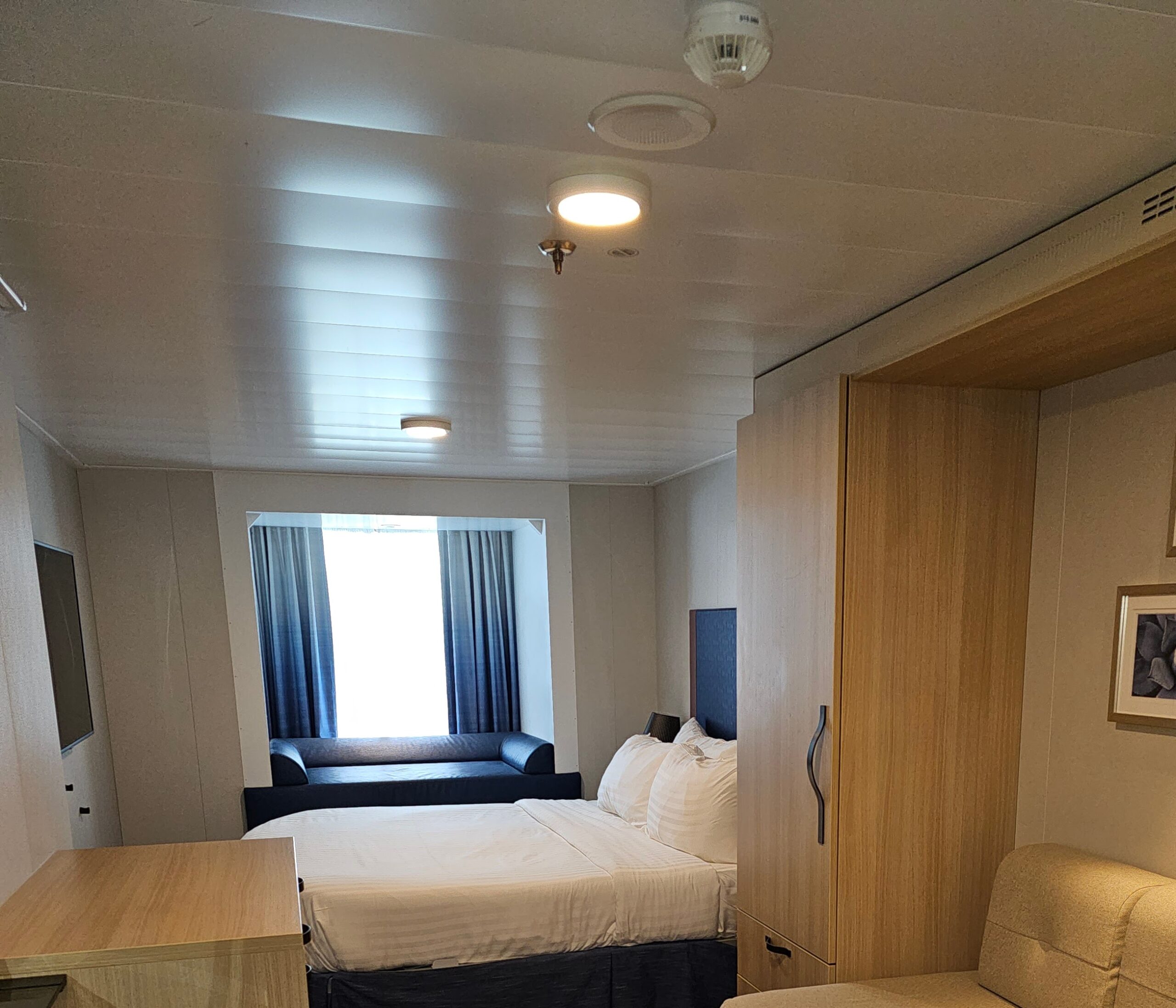Choosing a cruise cabin that’s just right for your family can feel like trying to solve a puzzle—balcony, oceanview, suite, inside—each one promising a different mix of comfort, convenience, and cost. And let’s be honest: with today’s mega-ships offering everything from family bunk rooms to convertible balcony spaces, it’s no longer a simple pick-and-go decision.
After sailing dozens of family cruises (and sampling just about every cabin category along the way), I’ve learned that your stateroom choice is the decision that most affects both your comfort and your budget. For a family of four, the jump from an inside cabin to a balcony can easily add $2,000–$4,000 to your fare. But spending more doesn’t always mean getting a better experience—it’s about matching what your family actually needs to what you’re paying for.
In this guide, I’ll break down the four main cabin types, what’s new on modern ships, and how to choose the best fit for your family—so you can skip the confusion and start counting down to sail away.
*Cabin sizes, pricing, and configurations vary significantly by cruise line, ship class, sailing date and port of embarkation. Always check your specific ship’s deck plan and cabin chart.*
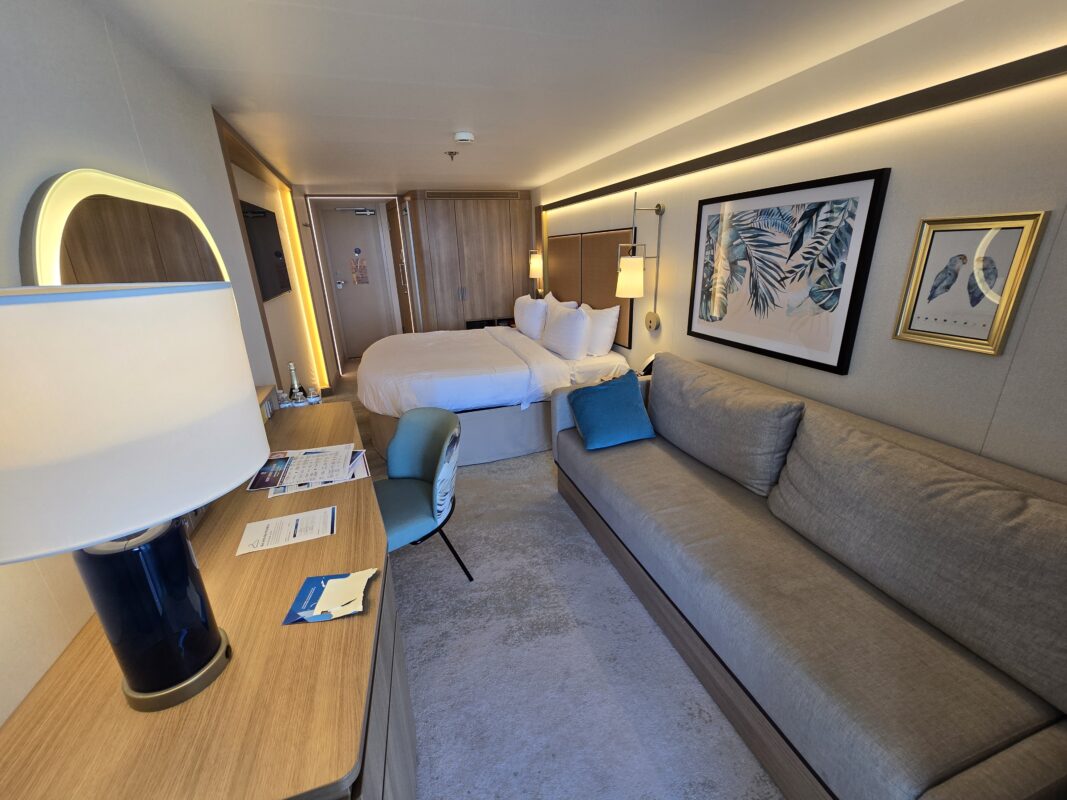
The 4 Main Cabin Types (And Who They Work For)
Inside Staterooms: Maximum Budget Savings
Inside staterooms have no windows, no views, and no access to outside air. They’re typically the smallest cabins (150 to 175 square feet) and have the lowest rates.
Who should book inside cabins: Families who won’t spend much time in the cabin. If you’re planning to be at the pool, eating in the dining rooms, watching shows, and exploring ports from morning to night, you’re essentially paying for a place to sleep and shower. An inside cabin delivers that at the lowest price.

This can be a strong pick for families with one child, couples on a budget, or anyone who wants to redirect cruise savings toward shore excursions or specialty dining.
Important note: You can always access natural light and fresh air by going to public areas of the ship. If your cabin is one deck above the pool and near the stairs, you could reach outside spaces in under a minute. Consider your cabin’s location when weighing inside versus outside options.
Oceanview Staterooms: Natural Light Without the Balcony Price
Oceanview cabins (also called outside cabins) have a window or porthole facing outside the ship. They’re similar in size to inside cabins (150 to 185 square feet) but provide natural light and some view of the ocean. The window does not open, so you don’t get fresh air.
Who should book oceanview cabins: Families who want natural light but don’t need immediate outdoor access. If you’re comfortable stepping outside to public decks for fresh air, an oceanview cabin delivers light at a lower price than a balcony. The interior living space in an oceanview cabin and a balcony cabin is about the same—you’re essentially paying extra for the private outdoor deck when you upgrade to a balcony.

Be forewarned: Not all oceanview cabins have unobstructed views. Window size varies by ship. You might get a small porthole with a view of a lifeboat, pole, or mechanical equipment. Call the cruise line or have your travel agent call to get specific details about window size and potential obstructions for your cabin before booking.
Balcony Staterooms: Private Outdoor Space
Balcony cabins include a private outdoor deck attached to your stateroom. The interior space is similar to an oceanview cabin, but you add a balcony with at least a table and a couple of chairs (some include loungers). You can step outside anytime for fresh air and ocean views without leaving your room.
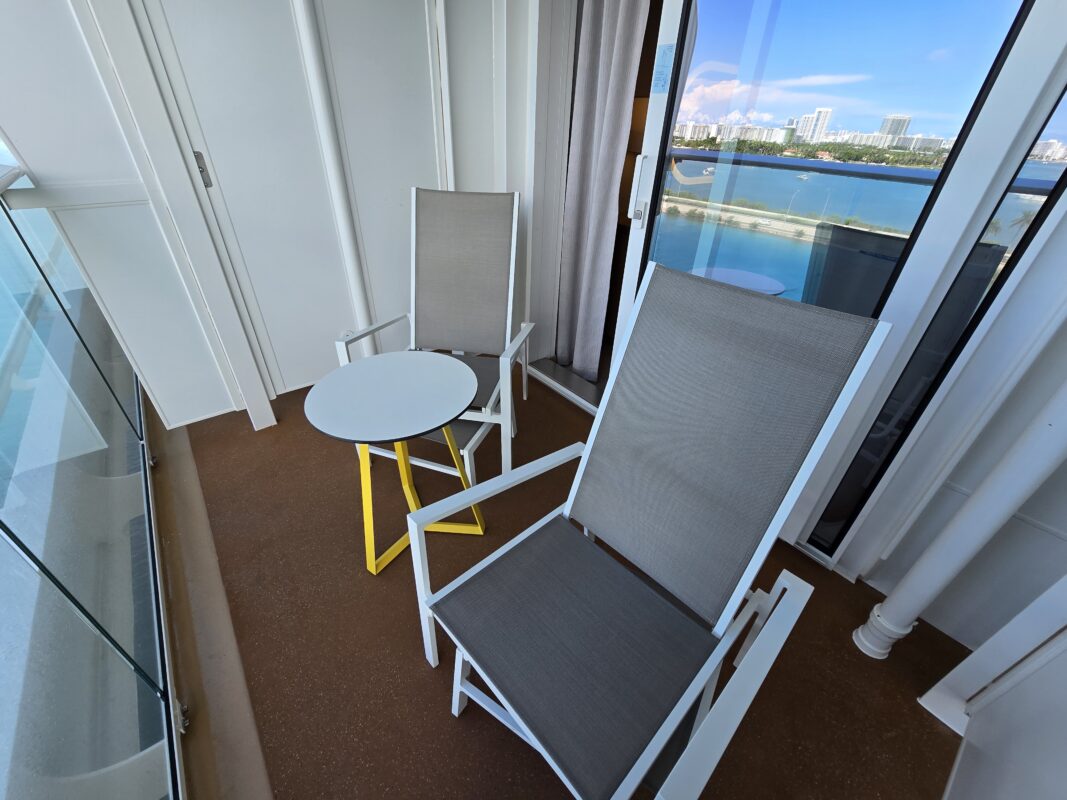
Who should book balcony cabins: Families who value private outdoor space, especially during nap times or quiet moments. Balconies work well for families with small children—you can enjoy the outdoors while kids sleep inside. They’re also advantageous for scenic itineraries like Alaska, where you can watch scenery from your own space without competing for public deck spots.
Balcony cabins can be a strong choice for families with small children. If you’re concerned about young kids accessing balconies, read our post about making your cabin safe for babies and toddlers.
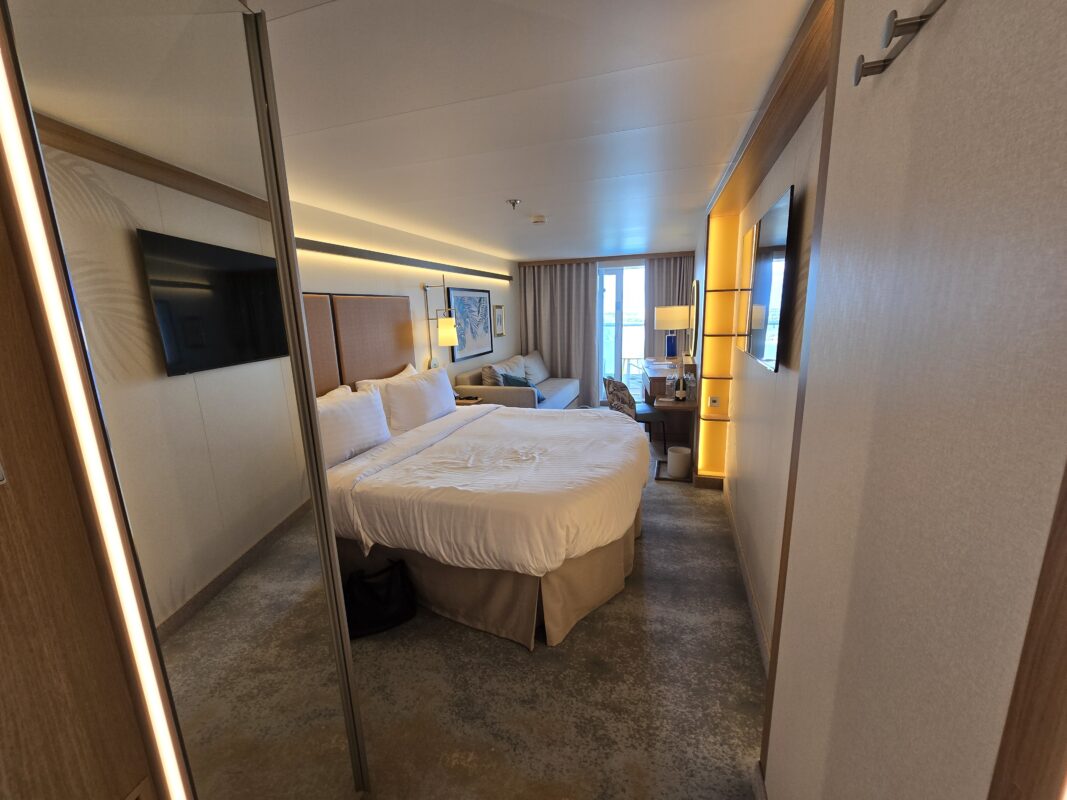
Suites: Extra Space and Premium Perks
Suites are significantly larger than standard staterooms with a defined living space separate from the sleeping area. Suites have bigger balconies (some with 180-degree wrap-around decks) and come with premium amenities: high-end toiletries, quality robes and slippers, early reservation access, and VIP treatment at embarkation and disembarkation. Suite passengers often get access to exclusive restaurants, lounges, spa facilities, or pools.

Who should book suites: Families who need substantial extra space, families with four or more people who want comfort, or travelers who value premium service and exclusive access. Suites also work well for multigenerational trips where grandparents want separation from grandkids.
Important note: Suites often start at double the cost of a balcony room per person.
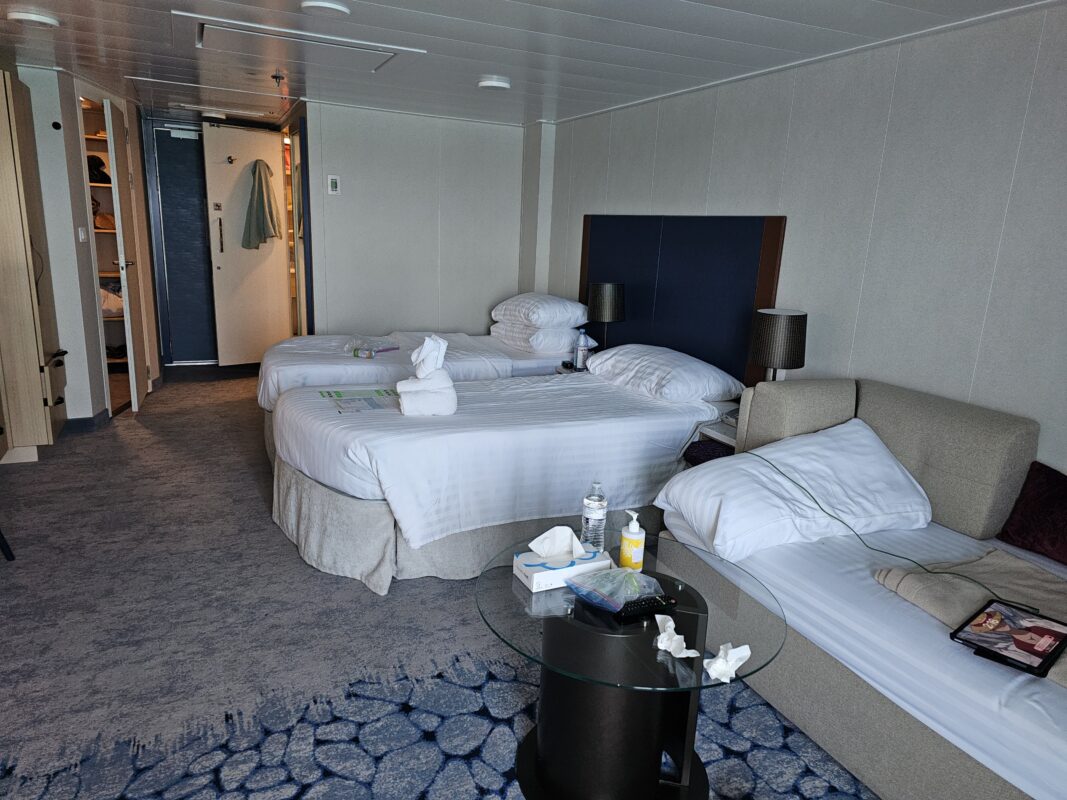
Choosing a Cruise Cabin: What’s Changed in Recent Years
More Options for Larger Families
Royal Caribbean’s Icon-class ships (Icon of the Seas, Star of the Seas) now offer 28 different stateroom types. Many of these cabins are designed for larger families—a significant shift from older ships where most cabins maxed out at four people.
Family Infinite Ocean View Balcony rooms sleep up to 6 guests with a separate hideaway bunk space for kids. Kids get their own beds, their own TVs, and privacy from the main sleeping area. A split bathroom design separates the shower and toilet, eliminating morning bottlenecks when multiple people need to get ready.

Royal Caribbean’s Surfside Family Suites sleep up to 4 guests (2 adults and 2 kids) with a spacious split bathroom and kids’ nook with sofa. These are typically priced 30% to 50% less than a full suite—a strong middle-ground option for families who need more space but can’t afford ultra-premium suites.
More Connecting Rooms
Carnival’s Excel-class ships offer a large number of connecting rooms (hundreds of pairs on some ships). You can find connecting options across all cabin categories, from inside to balcony.
Connecting cabins have an interior door that opens between two separate staterooms. This gives you double the space, two bathrooms, two TVs, and full separation between rooms. It’s ideal for families with teens who want privacy, or for traveling with extended family.
Cost comparison: For a family of five, booking a balcony plus an adjacent inside room often costs less than a suite sleeping five. Plus, you gain two bathrooms and more flexibility.
Balconies That Transform at the Push of a Button
Celebrity Cruises introduced Infinite Veranda staterooms on Edge-class ships. Floor-to-ceiling windows open at the push of a button, transforming your living space into an open-air balcony. Royal Caribbean’s Icon-class ships offer Spacious Infinite Balcony rooms with a similar concept.
This design gives you more usable indoor space when weather is cool and instant access to outdoor air when you want it. The balcony doesn’t protrude from the ship, so you get a wider interior footprint.
Ultra-Luxury Family Suites
Royal Caribbean’s Icon-class ships feature Ultimate Family Townhouses sleeping up to 8 guests across multiple levels. These include an in-suite slide, private cinema with popcorn machine, wrap-around terrace with hot tub, and direct access to the Surfside neighborhood.
Norwegian Aqua has expanded Haven suite complexes with similar family-focused ultra-suites. These start at $2,000+ per person for a 7-night cruise but include butler service, exclusive venues, and early reservation access.
Enhanced Inside Cabins
Disney offers “virtual” portholes on select ships—video monitors showing real-time views outside the ship, with Disney characters occasionally appearing in the feed. Royal Caribbean offers inside cabins with windows facing interior neighborhoods like Central Park or the Boardwalk, plus “virtual balconies”—floor-to-ceiling screens projecting ocean views.
On some ships, enhanced inside cabins are available at a modest premium over standard inside cabins and still significantly less than balcony cabins.
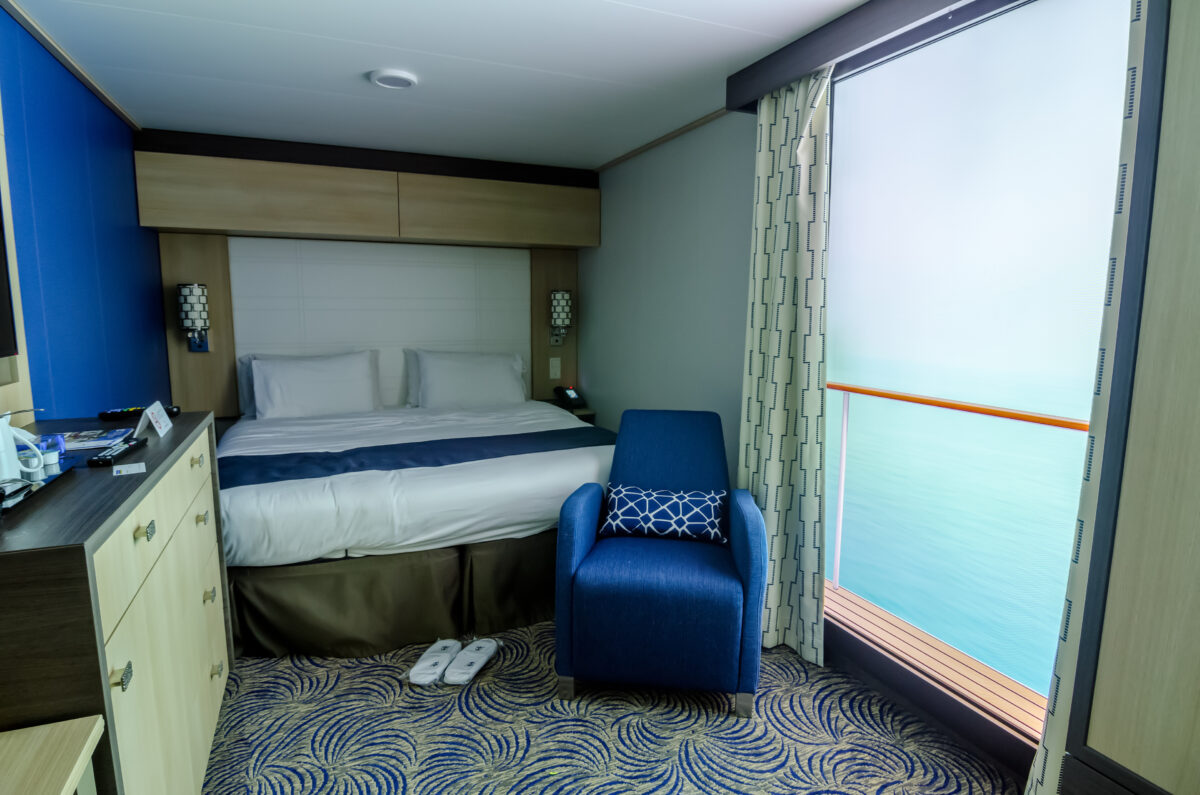
4 Questions To Answer Before Booking
1. How many people are in your travel party?
For two adults and one small child: A standard inside or oceanview cabin (150 to 175 square feet) works fine.
For two adults and two kids: A standard balcony cabin works if kids are small. Consider new family staterooms with split bathrooms or connecting cabins if kids are older.
For five or more people: Look at family staterooms designed for larger groups, connecting cabins, or the budget-smart combo of one balcony plus one adjacent inside room. Run the math on connecting rooms versus a suite—connecting rooms often cost less and give you two bathrooms.
2. How much time will you actually spend in your cabin?
If your cabin will primarily be for sleeping, bathing, and storing luggage, size and amenities matter less. An inside or oceanview stateroom could be quite comfortable and affordable.
If your family loves to lounge in your room, or you have four or more people, get the most square footage you can reasonably afford. Non-suite cabins measure 150 to 190 square feet. Smaller entry-level suites start at 250 to 300 square feet. Royal Caribbean’s Ultimate Family Townhouse measures approximately 2,000 square feet across three levels.
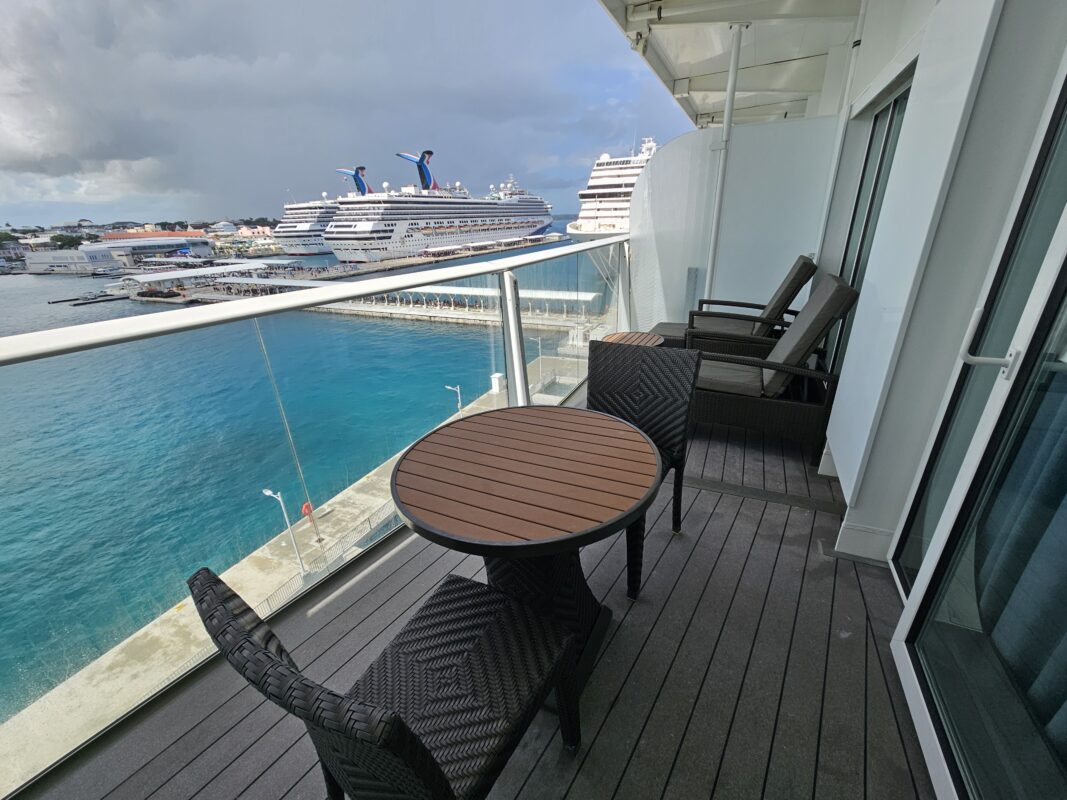
3. Do you need immediate outdoor access for naps or quiet time?
So, when is it worth getting a balcony on a cruise? If you have babies or toddlers who nap, or if you want a quiet outdoor space away from pool deck crowds, a balcony delivers real value. You can read, work, or relax while kids sleep inside.
If your kids don’t nap and your family is comfortable using public spaces for outdoor time, save money with an inside or oceanview cabin.
4. What’s your budget flexibility?
Inside versus balcony for a family of four on a 7-night cruise can mean a difference of $2,000 to $4,000 total. Oceanview cabins fall in the middle, usually $500 to $1,500 less than balcony.
If your budget is tight, an inside cabin frees up money for shore excursions, specialty dining, or a longer cruise. If you have flexibility, a balcony offers private outdoor space and extra square footage.
Worth keeping in mind: Cabin costs vary significantly by sailing date, itinerary, and cruise line. Caribbean cruises tend to have lower per-night rates than Alaska cruises. Booking 6 to 12 months in advance typically gets you better cabin selection and lower prices.
Smart Budget Strategies for Families
The Balcony-Plus-Inside Combo
Book one balcony and the adjacent or nearby inside room. Family members sleeping in the interior room still have easy access to the balcony by stepping across the hall. Your family gains two bathrooms, more storage space, and separation for different sleep schedules—all while spending less than a suite.
Connecting Rooms Versus Suites
For families of five or more, it’s worth comparing connecting rooms to a suite before you book.
Connecting cabins—such as a balcony paired with an adjacent inside room—give your family two separate spaces, two bathrooms, and greater flexibility for different bedtimes or morning routines. This setup often provides more total square footage at a lower overall cost than booking a single suite, especially on mainstream cruise lines.
Suites, on the other hand, offer a more luxurious experience: larger shared living areas, upgraded furnishings, priority services, and access to exclusive venues. The best choice depends on what matters most to your family—space and practicality, or elevated amenities and convenience.
Enhanced Inside Versus Standard Balcony
If natural light matters more to you than having a private outdoor space, it’s worth comparing enhanced inside cabins to standard balconies.

Enhanced inside cabins—such as Royal Caribbean’s interior rooms with Boardwalk or Central Park views—offer natural light through interior-facing windows or “virtual balcony” screens that project real-time ocean views. These rooms provide many of the visual benefits of a balcony without the higher fare.
A standard balcony cabin, by contrast, adds a private outdoor deck where you can enjoy fresh air and sea views anytime. It’s ideal if you plan to spend quiet time in your stateroom or prefer private outdoor space.
In short, enhanced inside cabins offer a smart middle ground: natural light and atmosphere at a lower cost, while balcony cabins deliver personal outdoor access and more total living space.
Once you’ve chosen your cabin, it’s amazing how a few simple touches can make it feel even more personal and comfortable. Check out our guide to cozy cabin hacks for ideas to make your stateroom feel like home.
Closing Thoughts
The best cruise cabin is the one that fits how your family actually travels—not just your budget. Think about your routines, how much time you’ll spend in the room, and how much privacy or flexibility you really need.
For larger families, today’s ships offer more creative layouts than ever before. Look for connecting rooms or family staterooms with split bathrooms before jumping to a suite. If you’ll be out exploring from sunrise to late evening, an inside cabin can make practical sense without compromising comfort. And if you love quiet mornings, sea breezes, or a place to unwind while kids nap, a balcony is worth the upgrade.

Elaine Warren
Founder & Crew Chief
Elaine founded this website after publishing the book The Family Cruise Companion’s Guide to Cruising With Kids. (Second edition recently released!) She has sailed on 45 cruises (and counting). She loves helping families navigate their way to an adventure-filled, fun, and memorable vacation.

